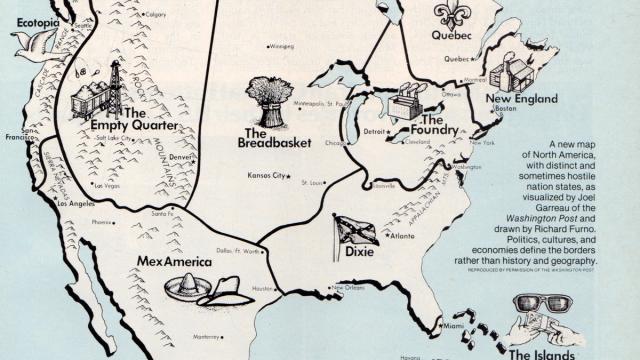Billionaire venture capitalist Tim Draper recently proposed splitting California up into six distinct states. Draper’s plan is getting a good deal of ridicule in the press, despite the fact that it could actually make its way to California ballots in the next election. But it’s easy to forget that throughout history, political boundaries have indeed been redrawn to suit different needs.
Or there are maps redrawn in the theoretical, to get a better sense of how divisions in the country actually manifest themselves. In the early 1980s, Washington Post editor Joel Garreau outlined the nine different Americas he and his fellow journalists saw when they looked at a map of North America.
Garreau wrote in 1981:
I’m going to try to explain how the continent is really working right now, not as if it were three nations — the United States, Canada, and Mexico; not as if it were 50 states; not as it should work, as an academic might have it; but how it is really working and how best to understand how we will be moving into the 21st century as a result.
Garreau thought of North America as distinct regions, from the nation of Dixie in the south, centered around the capital city of Atlanta, to the nation of Ecotopia in the northwest, encompassing the coastal regions of Northern California, Oregon, Washington state and British Columbia, with San Francisco as its capital.
Garreau divided North America up in this way because, as a reporter, he didn’t understand the regional divisions that had become the shorthand by which journalists described different parts of the United States. What do we mean when we describe regions like the Southwest or the Midwest?
“To this day I don’t understand what people mean by the Midwest,” Garreau wrote in 1981. “I don’t know why they would want to put Ohio in the same region as Nebraska; Cleveland is very different from Omaha. Its people are different, as are its industry, farming, and its future.”
And so Garreau redrew the continent in a way that made more sense to him, with each region getting a new capital city.
- Ecotopia — Capital: San Francisco
- The Empty Quarter — Capital: Denver
- MexAmerica — Capital: Los Angeles
- The Breadbasket — Capital: Kansas City
- Dixie — Capital: Atlanta
- The Foundry — Capital: Detroit
- Quebec — Capital: Quebec
- New England — Capital: Boston
- The Islands — Capital: Miami
“I am really convinced that where you are from tells a lot about where you are coming from,” Garreau wrote in 1981. “I think people are really influenced by their surroundings, where they are, and I think ultimately that’s why we are nine nations. We do have a certain dual allegiance. While we have passports that say United States or Canada or Mexico, we somehow feel some allegiance to the Plains or to South Florida or to the Northeast.”
Garreau’s choice of capitals and particular divisions are questionable in many ways, but they’re an interesting jumping off point for a discussion about how we understand the different regions of the United States, Canada and Mexico. People even took his ideas and wrote short stories based on the new potential divisions.
Garreau’s reimagining may have been largely a thought exercise, but there have been plenty of real attempts to redraw the political boundaries of North America. Those lines of the map that divide Minnesota from Wisconsin or the U.S. from Mexico were decided by humans. And they can be redrawn by humans should the desire arise, whether we want to form new tangible governmental structures or just as a shorthand to describe different regions.
So what do you think about Garreaut’s map? Does it makes sense at all here in the 21st century? How would you redraw North America or even just California?
Image: Richard Furno illustration scanned from the August 1980 issue of The Futurist magazine
